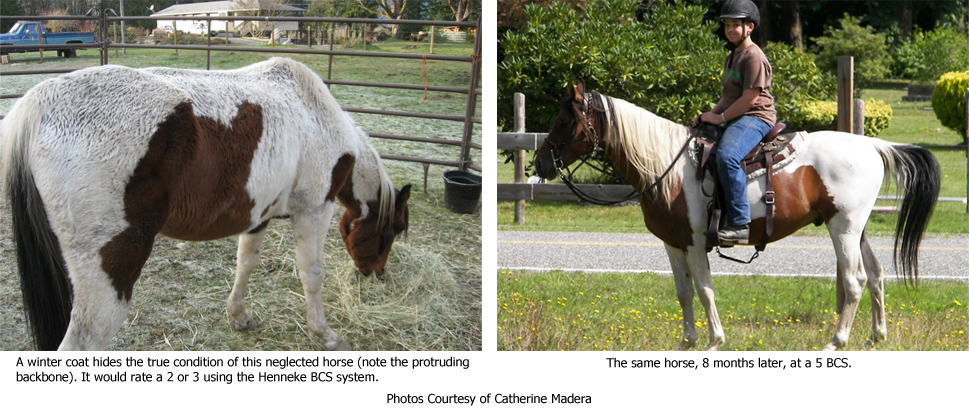How to Evaluate Your Horse’s Body Condition
by Dave Sauter, DVM
There is something very pleasant, especially on a cold, blustery, winter night, about bringing the horses in the barn and into clean, dry stalls. The best part is listening to the sounds of the horses eating their feed. All is well. Or is it? Part of the answer to that question has to do with our horses’ weight and body condition. For all animals there are health problems associated with being either too thin or too fat. Overweight horses are at higher risk of laminitis, metabolic problems, overheating on hot days and poor performance. Underweight horses suffer in cold weather, have weakened immune systems, are physically weaker and prone to skin diseases. Additionally, their condition may lead to a surprise and unwelcome visit from the Humane Society.
How do we determine if our horses are at a healthy weight? In a world of many breeds and people of differing experience and opinion, it can be confusing. Fortunately there are tools available to standardize our methods so that an objective assessment can be made. There are two important aspects of the assessment. One is the horse’s weight. A scale is, of course, the only direct method of weighing a horse. Two other methods allow us to estimate weight. A weight tape, which correlates heart girth size with weight, is available commercially. Used properly, the weight tape is applied around the heart girth an inch behind the highest aspect of the withers, with the horse standing squarely on a flat, level surface. Our clinic has compared the results using our weight tapes with those from an actual scale. Rarely have the two have matched and often they differed by as much as a 100 pounds. Another method of estimating a horse’s weight utilizes a formula that requires two measurements of the horse: the heart girth (like a weight tape) and the distance from the point of shoulder to the point of the buttock. These two measurements are then plugged into a formula which estimates the volume of the horse and correlates it with weight. There are several apps available that will make the calculation for you. Some are free, such as “Equine Weight Calculator.”

Weight is useful to track an individual to determine if it is gaining or losing weight. To determine if the weight is healthy or not we need The Henneke Body Condition Score (BCS). Developed over 30 years ago, it is one of the more commonly recognized and used BCS systems. Properly used it objectively assigns a BCS that is based on the amount of fat on the horse’s body in six specific areas. It is very important to not only look but to also to feel these areas, particularly in winter when the heavier hair coat covers up the horse’s true appearance. The BCS range goes from 1 (emaciated) to 9 (obese) with an optimum score of 5 (moderate). Many people prefer their horses to look moderately fleshy, especially in the winter, a BCS of 6.
Once a weight assessment is made, we can determine how to correct any problems. There are several areas to examine.
- Nutrition. This a natural place to start. There is more to nutrition than simply the energy content of the feed (i.e., the calories), such as protein, macro-& micro-minerals, vitamins, minerals and fiber. Evaluating the feed program and weighing feeds can help determine if horses are getting fed properly and what sort of changes to make.
- Management issues. This is how the feeds are presented to a horse: if there is competition for food and water and proper shelter from harsh weather. For example, an older horse might eat slowly and need to be separated from the other horses to ensure it gets what it needs.
- Parasites. A common problem for the thin horse is internal (worms) and external (lice, mites). Parasites compete for nutrients; some cause anemia and some damage the digestive system and internal organs, impairing the ability to assimilate food. Although we may joke that fat horses have a “parasite deficiency,” we want to control parasites in all horses.
- Dentistry. This is a common cause of poor body condition. The first stage of digestion begins with chewing. If not properly chewed, food won’t get digested well and the horse won’t get as much out of it. Many dental problems can be improved upon with proper dental care, ensuring that the horse can chew comfortably and get a good start on digestion.
- Medical issues. Illness, chronic disease, injury and chronic pain can be concerns for the thin horse. Medical problems plague the overweight horse also and include Cushing’s disease or Equine Metabolic Disease. A thorough physical examination and laboratory work can help uncover problems such as these.
After recognizing the underweight or overweight horse by monitoring weight and using the Henneke BCS and after exploring the underlying causes, a safe and patient plan can be devised to strive for a healthy weight. Your veterinarian can be helpful in this process.
Published in January 2016 Issue

Dave Sauter is a Minnesota native and graduated from the University of Minnesota in 1987. Following graduation he interned at Rood and Riddle Equine Hospital in Lexington, Kentucky. After this internship, he continued to work exclusively with horses for another five years in Kentucky before moving out West and joining Kulshan Veterinary Hospital in Lynden, WA. He is a member of the AAEP, AVMA and the WSVMA. For more information about Kulshan Veterinary Hospital call 360-354-5095 or email [email protected]. www.KulshanVet.com






